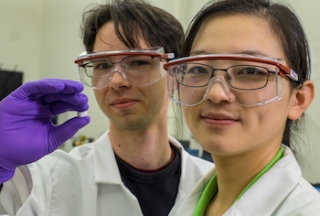Jan 13 2016
Rice University scientists have invented an adaptive material, called self-adaptive composite (SAC), that combines reversible self-stiffening and self-healing properties. SAC comprises a solid matrix composed of sticky micron-scale rubber balls.
 Graduate student Alin Cristian Chipara and postdoctoral researcher Pei Dong show a sample of their self-adaptive composite, which they say shows potential for tissue engineering or lightweight structural applications. Photo by Jeff Fitlow
Graduate student Alin Cristian Chipara and postdoctoral researcher Pei Dong show a sample of their self-adaptive composite, which they say shows potential for tissue engineering or lightweight structural applications. Photo by Jeff Fitlow
SAC was developed by combining two polymers and a solvent that evaporate and leave a porous mass of gooey spheres when heated. The matrix heals when cracked and regains its original form, just like a sponge after compression.
Rice materials scientists, Pulickel Ajayan and Jun Lou, headed the study "ACS Applied Materials and Interfaces," published in the American Chemical Society journal. They propose that SAC could be a useful, biocompatible material engineering for tissue or a lightweight, defect-tolerant structural component.
There are other "self-healing" materials that encapsulate liquid in solid shells, these shells leak their healing contents when cracked.
Those are very cool, but we wanted to introduce more flexibility. We wanted a biomimetic material that could change itself, or its inner structure, to adapt to external stimulation and thought introducing more liquid would be a way. But we wanted the liquid to be stable instead of flowing everywhere.
Pei Dong, Postdoctoral Researcher
Self-adaptive material heals itself, stays tough
In SAC, much of the liquid is encapsulated in very small spheres of polyvinylidene fluoride (PVDF). The complete surface is coated with the viscous polydimethylsiloxane (PDMS). Lou highlighted the resilience of the spheres as their thin shells deform easily. Viscoelasticity is the the measure of the spheres ability to absorb the strain and then return to their original state, and in this case the viscoelasticity is improved by the liquid content in the spheres. The spheres are kept together by the coatings, though they also have the capability to slide against each other when they are compressed, yet remain attached.
The sample doesn’t give you the impression that it contains any liquid. That’s very different from a gel. This is not really squishy; it’s more like a sugar cube that you can compress quite a lot. The nice thing is that it recovers.
Jun Lou, Professor of Materials Science and Nanoengineering and Chemistry
Ajayan stated that making SAC is a simple process that can be tuned - by adding a little more liquid or solid - to control the product’s mechanical behavior.
Gels have lots of liquid encapsulated in solids, but they’re too much on the very soft side,” he said. “We wanted something that was mechanically robust as well. What we ended up with is probably an extreme gel in which the liquid phase is only 50 percent or so.
Pulickel Ajayan, Chair of Rice’s Department of Materials Science and NanoEngineering
Dong stated that the polymer components start as powder and viscous liquid. The PDMS stabilizes into solid spheres by adding a solvent and using controlled heating, and the reconfigurable internal structure is provided by these spheres. Through a number of test, Rice scientists discovered a 683 percent increase in SAC’s storage modulus - a size-independent parameter that helps to characterize self-stiffening behavior. This parameter is much larger than suggested for solid composites and other materials.
According to Dong, sample sizes of the putty-like material are limited only by the container they are made in, "right now, we’re making it in a 150-milliliter beaker, but it can be scaled up. We have a design for that."
Co-authors are Rice postdoctoral researchers Bo Li, Yingchao Yang, Hua Guo, Liehui Ge and Liang Hong; graduate student Sidong Lei; undergraduate students Bilan Yang and Qizhong Wang; alumnus Phillip Loya; Emilie Ringe, an assistant professor of materials science and nanoengineering and of chemistry; Robert Vajtai, a senior faculty fellow in materials science and nanoengineering, and Ming Tang, an assistant professor of materials science and nanoengineering; Mircea Chipara, an assistant professor of physics and geology at the University of Texas-Pan American, and postdoctoral researchers Gustavo Brunetto and Leonardo Machado and Douglas Galvao, a professor at the State University of Campinas, Brazil.
Ajayan is chair of Rice’s Department of Materials Science and NanoEngineering, the Benjamin M. and Mary Greenwood Anderson Professor in Engineering and a professor of chemistry. Lou is a professor of materials science and nanoengineering and of chemistry and associate chair of the Department of Materials Science and NanoEngineering.
This research was supported by the Air Force Office of Scientific Research and the Department of Defense.